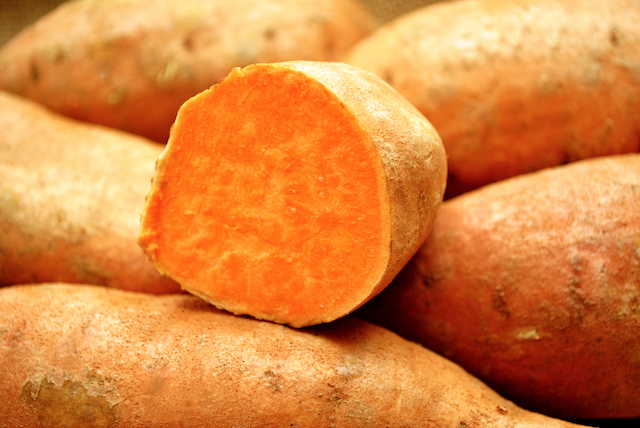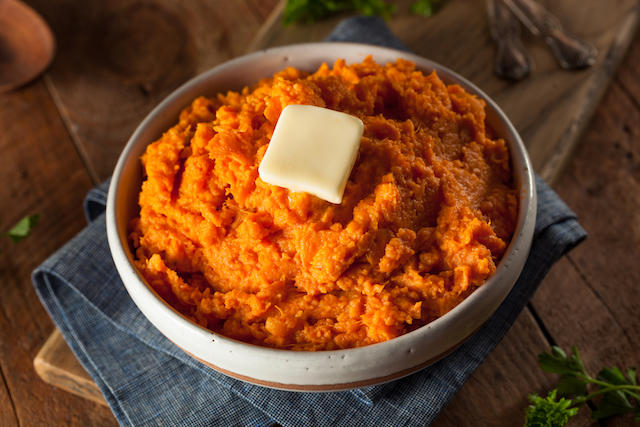- Home
- Blog
- Healthy Eating for Wellness
- Potatoes – white vs sweet?
Potatoes – white vs sweet?
Written by Catherine Saxelby
on Wednesday, 11 March 2020.
Tagged: health, healthy cooking, healthy eating, healthy lifestyle, nutrition, vegetables

I’m often asked should I swap my white potato for the golden ones, often called sweet potatoes or kumara, with their orange flesh? It’s a fair question given the interest in low-carb eating as well as the lower GI of the sweet potato. Let’s take a look...
When I was growing up, we used to call the gold potato “kumara” which is the Maori word for sweet potato. It would sometimes feature in a Sunday roast but that was about it. Today you can find the same long gold potato Ipomoea batatas baked and loaded or boiled and served as mash or fried into long thin chips and served in place of white potatoes.

Let’s compare them
When you do the comparison, it seems that gold and white potatoes are pretty similar in nutrition – both have:
- Almost no fat
- The same protein, fibre and sodium
- Around the same kilojoule count – 100 g of boiled sweet gold potato supplies 290 kJ compared to 280 kJ for white-fleshed varieties. This is hardly a big difference and even if you drill down into specific varieties they all come out close to each other. For instance, Desiree come in at 231 kJ, Pontiac at 266 kJ, while Sebago are 279 kJ.
- Around the same count of carbs – 100 g of sweet potato supplies 15 grams compared to 14 grams for white-fleshed varieties
The one big difference is in the amount of natural sugars in the gold potato which is six times greater than the regular white potato. This is understandable once you taste it. It tastes sweeter!
Potato for a lower GI
If you asked anyone out there what they know about sweet potato and its health benefits, most will say that it has often been chosen for its lower Glycaemic Index or GI. GI ranks carbohydrates from 0 to 100, based on how much and how fast they affect blood glucose (blood sugar) levels. A higher number means the food has a larger impact on blood glucose levels. Glucose itself has a ranking of 100.
For GI, anything below 55 is considered Low, and anything over 70 is High. Numbers from 55 to 69 are in the Medium range. You can find out more here.
We thought the lower GI was due to the presence of fructose in the natural sugars of the gold potato. Not so. The sugars were highest in sucrose, then glucose and finally fructose. These ratios held during boiling or baking too. So it must be just the different type of starchy carbs.
At 44, that gold sweet potato falls into the LOW GI category – which is great. In contrast, an average white potato is high in GI at 89. Even if we’re wrong by 10, you still get a potato substitute that’s lower in GI.
 People with diabetes are recommended to consume only modest amounts of carbohydrates, and to choose ones that are low GI (and ones that are high in fibre) to avoid the blood sugar highs. So, they often steer clear of white rice, white bread and similar high-GI carbs and swap to low GI rice such as Doongara, grainy bread and this gold sweet potato. As well as legumes like lentils and black beans.
People with diabetes are recommended to consume only modest amounts of carbohydrates, and to choose ones that are low GI (and ones that are high in fibre) to avoid the blood sugar highs. So, they often steer clear of white rice, white bread and similar high-GI carbs and swap to low GI rice such as Doongara, grainy bread and this gold sweet potato. As well as legumes like lentils and black beans.
Being low GI, sweet potato offers a great alternative to the humble potato for those living with diabetes when eaten in moderation and in the context of a balanced diet.
In addition, you get:
- Lots of beta-carotene which gets converted to vitamin A.
- More (but not a huge amount) of vitamin C
- Potassium, a mineral which helps to regulate blood pressure, is often claimed to be higher in the gold potato but the figures don’t show this. However, it will depend on the variety and how it is cooked. Don’t boil in huge volumes of water which leaches out any minerals and this is then discarded.
See my table of comparison. Both are for 100 grams of fresh peeled, boiled then drained spud.
|
Component |
Gold potato |
Regular white potato |
|
Energy kJ Cal |
290 69 |
279 66 |
|
Protein, g |
2 |
2 |
|
Fat total, g |
0.1 |
0 |
|
Carbohydrate, g |
15.2 |
14.2 |
|
Sugars, g |
6 |
0 |
|
Dietary fibre, g |
2.7 |
2.4 |
|
Sodium, mg |
10 |
11 |
|
Beta-carotene, μg |
6032 |
0 |
|
Vitamin C, mg |
25 |
9 |
|
Potassium, mg |
242 |
441 |
From AFCD Australian Food Composition Database - Release 1.0
How much is a serve?
Half a cup of cooked sweet potato provides one serve of vegetables. This means around 100 grams boiled or baked.
Gold potatoes all the buzz
The most common type of sweet potato is the gold variety, which is long (shaped like a tuber), has a dull orange skin and bright orange flesh. The variety is Beauregard, known for its sweetness and moistness and is best for mashing and baking
Don’t confuse the sweet potato with yam or taro, a starchy root vegetable popular in the Pacific Islands and New Guinea. These two vegetables are produced by different species of plants.
 The bottom line
The bottom line
When you stack them up side by side, there’s not much between white and gold potatoes for their sheer numbers. But you get more beta-carotene and a less of an impact on your blood sugars if you choose the sweet potato. So, I’d say those sweet potato fries and mash are well worth it.
Foodwatch
The Good Stuff
The Boring Stuff
© 2025 Foodwatch Australia. All rights reserved
Website by Joomstore eCommerce





